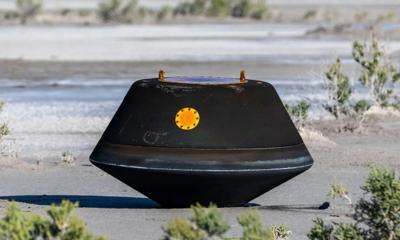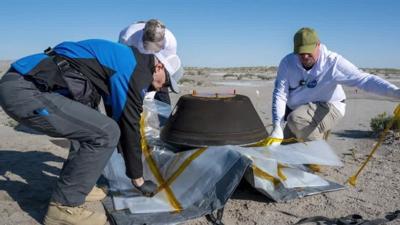Asteroid Regolith Samples Retrieved and Secured
The United States has retrieved rocks and dust from an asteroid and transported such back to Earth. The achievement occasioned the success of NASA’s Origins, Spectral Interpretation, Resource Identification and Security—Regolith Explorer (OSIRIS-REx) mission.

A capsule containing regolith collected from the asteroid 101955 Bennu landed in a targeted area of the U.S. Department of Defense’s Utah Test and Training Range near Salt Lake City at 08:52 MDT on the morning of Sunday, 24 September 2023.
By way of definition, 101955 Bennu is a carbonaceous asteroid discovered on 11 September 1999 by the joint USAF, NASA, MIT Lincoln Near-Earth Asteroid Research (LINEAR) Project. Regolith, conversely, is a geological term denoting the blanket of unconsolidated, loose, heterogeneous, superficial deposits covering the underlying bedrock of planets, planetoids, and asteroids.
Within ninety-minutes of landing, the capsule was retrieved and transported by helicopter to a temporary clean-room set up in a hangar on the training range, where it remains under constant supervision, sustained in a nitrogen-filled containment vessel. As nitrogen is inert—which is to say that the element doesn’t readily react with most chemicals—storing the regolith samples in nitrogen will preclude their being corrupted by Earthly contaminants, thereby preserving their scientific value.
101955 Bennu is a potentially-hazardous object listed on the Sentry Risk Table—a highly-automated impact-prediction system operated by the Jet Propulsion Laboratory’s (JPL) Center for Near-Earth Object Studies (CNEOS). The asteroid holds the highest cumulative rating on the Palermo Technical Impact Hazard Scale—a logarithmic scale utilized by astronomers to rate the likelihood of a Near Earth Object) impacting the Earth. Statistically, 101955 Bennu has a cumulative 1-in-1,750 chance of striking the Earth between the years 2178 and 2290, with the greatest risk being incurred on 24 September 2182. The asteroid is named for Bennu, the Egyptian mythological bird associated with the Sun, creation, and rebirth.
The regolith samples collected from Bennu will ostensibly help scientists better understand planetary formation and the origin of the organic compounds and water by which life on the primordial Earth was preceded. Researchers seek, also, to gain insight into the nature of potentially hazardous NEOs.
NASA Administrator Bill Nelson stated: “Congratulations to the OSIRIS-REx team on a picture-perfect mission – the first American asteroid sample return in history—which will deepen our understanding of the origin of our solar system and its formation. Not to mention, Bennu is a potentially hazardous asteroid, and what we learn from the sample will help us better understand the types of asteroids that could come our way.”

Mr. Nelson continued: “With OSIRIS-REx, Psyche launch in a couple of weeks, DART’s one-year anniversary, and Lucy’s first asteroid approach in November, Asteroid Autumn is in full swing. These missions prove, once again, that NASA does big things. Things that inspire us and unite us. Things that show nothing is beyond our reach when we work together.”
The Bennu sample, which comprises an estimated 8.8-ounces (250 grams) of asteroidal regolith, was transported via aircraft—in its unopened, nitrogen-containing canister—to NASA’s Johnson Space Center in Houston, Texas, on Monday, 25 September.
The OSIRIS-Rex) mission launched on 08 September 2016, landing on 101955 Bennu on 03 December 2018—a trip of two-years, ten-months, and ten-days. Sample collection commenced on 20 October 2020; the OSIRIS-REx spacecraft’s return trip to Earth got underway on 10 May 2021.
After traveling billions of Earthward miles over a period spanning two-years, four-months, and 14-days, the spacecraft neared to within 54,746-nautical-miles of the Earth’s surface—about one-third the distance by which the Earth and moon are separated—and released the sample capsule at 04:42 MDT on 24 September.
Four-hours later, the capsule—moving along at a velocity of 24,027-knots—entered Earth’s atmosphere off the coast of California. Airborne and terrestrial radar, infrared, and optical assets tracked the capsule to landing coordinates inside a 31-nautical-mile by 7.4-nautical-mile area within the DOD’s Utah Test and Training Range. Two parachutes deployed to stabilize the capsule and slow it to a leisurely 9.56-knot touchdown-speed.
Fewer than ten-minutes passed between the capsule’s atmospheric re-entry and its landing outside of Salt Lake City.
Recovery teams located the intact capsule at 09:07 MDT and determined it was safe to approach. Within seventy-minutes, personnel prepped the capsule for transport and started it on its way to the aforementioned temporary clean-room.

OSIRIS-REx principal investigator at the University of Arizona in Tucson Dante Lauretta set forth: “Today marks an extraordinary milestone not just for the OSIRIS-REx team but for science as a whole. Successfully delivering samples from Bennu to Earth is a triumph of collaborative ingenuity and a testament to what we can accomplish when we unite with a common purpose. But let’s not forget—while this may feel like the end of an incredible chapter, it’s truly just the beginning of another. We now have the unprecedented opportunity to analyze these samples and delve deeper into the secrets of our solar system."
Rich Burns, OSIRIS-REx project manager at NASA’s Goddard Space Flight Center in Greenbelt, Maryland, remarked: “The whole team had butterflies today, but that’s the focused anticipation of a critical event by a well-prepared team. For us, this was the World Series, ninth inning, bases-loaded moment, and this team knocked it out of the park.”
 Airborne 05.10.24: Icon Auction, Drunk MedEvac Pilot, Bell ALFA
Airborne 05.10.24: Icon Auction, Drunk MedEvac Pilot, Bell ALFA ANN's Daily Aero-Term (05.13.24): ILS PRM Approach
ANN's Daily Aero-Term (05.13.24): ILS PRM Approach ANN's Daily Aero-Linx (05.13.24)
ANN's Daily Aero-Linx (05.13.24) Airborne-NextGen 05.07.24: AI-Piloted F-16, AgEagle, 1st 2 WorldView Sats
Airborne-NextGen 05.07.24: AI-Piloted F-16, AgEagle, 1st 2 WorldView Sats Airborne 05.08.24: Denali Update, Dad-Daughter Gyro, Lake SAIB
Airborne 05.08.24: Denali Update, Dad-Daughter Gyro, Lake SAIB





